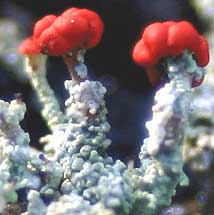Excerpts from Jim Conrad's
Naturalist Newsletter
from the February 1, 2004 Newsletter issued from the woods just west of Natchez, Mississippi, USA
BRITISH SOLDIER LICHENS
 The property owner has a digital camera and during his recent visit he photographed a ¼-inch high (6 mm) British Soldier Lichen growing atop a fencepost next to the barn. By tradition, the Latin name of a lichen is the name of its fungal component. The fungus part of the British Soldier Lichen is Cladonia cristatella, while the alga part is known as Trebouxia erici. On my lichen page you can both learn the basic facts about lichens at www.backyardnature.net/lichens.htm
The property owner has a digital camera and during his recent visit he photographed a ¼-inch high (6 mm) British Soldier Lichen growing atop a fencepost next to the barn. By tradition, the Latin name of a lichen is the name of its fungal component. The fungus part of the British Soldier Lichen is Cladonia cristatella, while the alga part is known as Trebouxia erici. On my lichen page you can both learn the basic facts about lichens at www.backyardnature.net/lichens.htm
At the top of that page one of my drawings shows how lichens are composed of two distinct organisms, a fungus and an alga. The drawing portrays fungal hyphae enveloping algal cells.
A British Soldier Lichen was the very first lichen I ever identified, because its bright red spore-producing top makes it so distinctive. I still remember the frigid January morning in Kentucky, back in the 1960s, when I discovered it, a beautiful little colony on the ground in a long-abandoned field overgrown with redcedars. To this day I associate the odor of redcedar with British Soldier Lichens.
Knowing the names of things is like that: The name gives you a mental pigeonhole. Then, into that pigeonhole, during the entire course of your life, you can insert all kinds of information, memories and associations. On the June day last year when I first came to this new location, one of the first things I noticed was the British Soldier Lichens appearing in the picture, and as the day's suffocating heat and horsefly hoards pooled around me, my mind for an instant thrilled to memories of a long-gone frosty January morning in Kentucky smelling of redcedar.